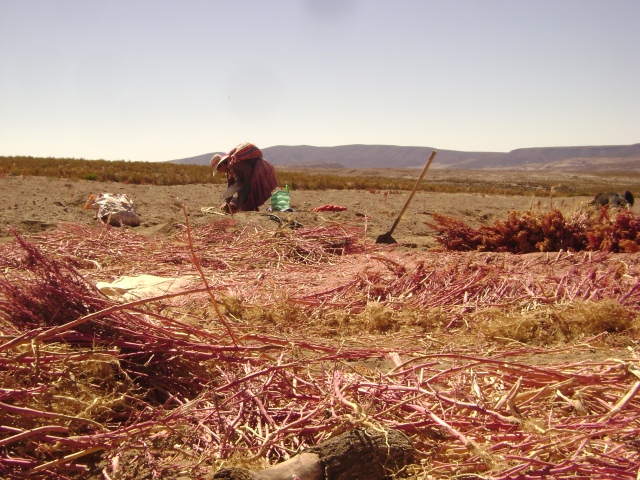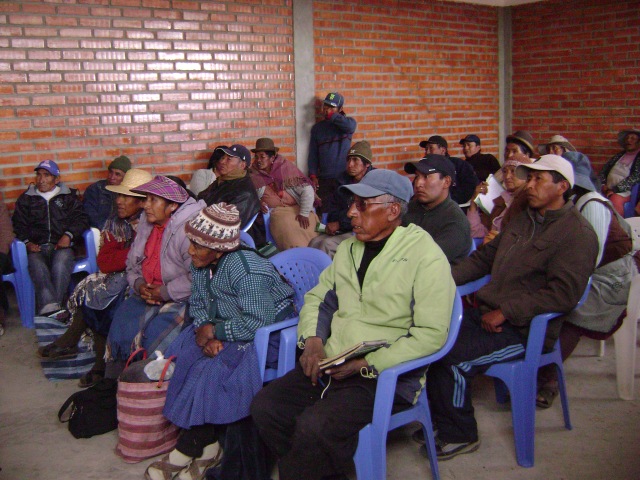Prices, sowing and the future: a question mark
By Gabriela Ruesgas
Over the last decade many peasant native indigenous communities in Bolivia have chosen to grow quinoa in view of the extremely high price in the global market. The prices soared to unprecedented levels and in the traditional communities increasing numbers of producers joined in this activity, expanding the agricultural frontier of this crop and generating a series of contradictions and tensions within the peasant communities.
In April and May, the months in which the quinoa growers are harvesting, I have participated in some of the centralized meetings in communities in the province of Nor Lípez together with leaders and technicians of the Association of Quinoa Real Producers “SOPROQUI”. The meetings addressed the problems, opportunities and challenges which the producers and association are presently facing.

Women harvesting quinoa, by Gabriela Ruesgas
The irreversible impact of the price boom
Historically, according to the producers the price of one quintal of quinoa never exceeded BOB 30 (equivalent to approximately USD 4 today). By the end of the 1990s, the price started to go up in a sustained manner, to over BOB 2,000 (approximately USD 300) in 2013. After this peak, the trend started to reverse and today the price of one quintal of quinoa sold in the market is BOB 360 (USD 52). Nonetheless, since quinoa has become part of the diet of important population sectors in central Europe, the US and elsewhere, the price will not go down again to the historical levels before quinoa entered the world market.
The recent price decline is primarily due to the multiplication of the producing countries, from the 3 or 4 traditional producers to the around 100 countries producing quinoa today. As Rodolfo Quispe, President of SOPROQUI, said “for us, the quinoa boom has meant a radical change but it is over and will not come back”. This was his way to express the understanding that although quinoa has become a fixed product in the world market, the extraordinary profits made after 2013 will not be repeated.
The results we see today show that even though quinoa has brought many benefits for the producers, at the same time it has given rise to several tensions. One of the most significant tensions is the pressure on the land, which has had a dual impact. On the one hand, socioeconomic impacts and, on the other hand, environmental impacts. In terms of the former, the SOPROQUI producers I spoke with confirmed that the boom gave rise to important changes in the social relations within the communities which were unthinkable before for them.
Doña Aquilina from the community of Bella Vista, a quinoa producer and partner of SOPROQUI, deplores the land conflicts between communities and even between families. She said that the communities of “Agencha with Aguaquiza, Llavica and Malil, they grabbed everything, they occupied everything… they interfered with the land, they moved the land around; all sectors were involved in fights and even brothers killed each other; all about ambition” (…) “it is true that people only come here for their own good. That is why they have come to my village, from Tarija, Tupiza, they have come to live here… some even came from Brazil, from Argentina, to claim land. The most cunning ones brought their children to occupy land and the ones with most money took more”.

SOPROQUI Quinoa producers meeting in Villag Candelaria, by Gabriela Ruesgas
She also told me that some migrants who claimed they were relatives of community members and settled in the community to produce quinoa took out loans and when the quinoa price went down they could no longer pay back the money. They fled the community and the guarantor is now stuck with their pile of debt. What Mrs. Aquilina told us shows the shocks and contradictions among the community members whose relations are based on mutual trust and on the knowledge they have of their families, on the one hand, and the migrants (residents) on the other hand. However, the latter came from the perspective of a calculation of opportunities and bringing other cultural practices and values which are essentially based on individual profit and benefit. That explains Aquilina’s assertion when she was talking about these experiences –which are very common in mercantile economies in which the individual interest prevails- “that is what has become of the quinoa growers (!!!)”, which she said with astonishment and also a certain disbelief. These stories may be seen as either anecdotes or the starting point of an in-depth investigation of the changes and transformations of cultural patterns in the communal relationships, which are exacerbated by the quinoa boom.
With regard to the second impact, namely the environmental pressure on the land, many problems have intensified. Soil erosion, the loss of camelid livestock and a series of local phenomena linked to the more generalized and global phenomenon of climate change are having a direct impact in the quinoa producing communities that now face the risk of not being able to sow in the next agricultural cycle. The producers told us that the problem of the price decline is worsened by the absence of rainfall, because of which it has not been possible to date (May 2016) to till and plow the land to prepare for sowing. This new reality entails new and difficult challenges for the producing communities with a view to having a less uncertain future.
New challenges for the producers
One common topic mentioned in the five centralized meetings of SOPROQUI -which were attended by community members from Yonza, Pelcoya, Santiago K, Santiago Chuvica, Mañica, Bella Vista, Puerto Chuvica, Colcha K, Copacabana, Santiago de Agencha, Aguaquiza and Atulcha-, was related to the association’s projections towards the future. Don Rodolfo Quispe made it very clear: “Quinoa is no longer good business; if we have no projections, our association will die”. Don Ignacio, a producer from Villa Candelaria, shared his concern that “the good times are in the past, so what alternative for survival do we have?” (…) “People will no longer fight over the land, they will merely leave”.
The quinoa price boom has had an irreversible impact on the quinoa producing communities, not only in terms of the benefits which the producers have received but also because of the important economic, cultural and institutional transformations that have taken place in the communities. As Don Ignacio pointed out, the first challenge is to explore the channels or mechanisms to maintain the conquests resulting from the price boom. In this regard, the producers have been discussing the possibility of industrializing and adding value to the quinoa production and/or of diversifying their productive activities.
In this new scenario, SOPROQUI leaders Rodolfo Quispe and Yamilé Cruz proposed to create an economic entrepreneurial unit that would focus on “agro-eco tourism”. A bold initiative on which the partners will vote in their next annual assembly in July of this year. This proposal intends to share the local uses and customs in organic quinoa production practices with the world, through the creation of a network of communal lodgings throughout the communities around the Uyuni salt flat.
These important challenges, which are not only related to the crisis which the producers face today but also to the dreams and objectives of individual and collective improvement were voiced very well by Don Rodolfo. In a meeting in the community of Llavica he said to the other members that “I remember this dream of our friend Yamile… of SOPROQUI becoming a big quinoa company with worldwide presence just like Coca Cola”.

Gabriela,
This is a really interesting blog. Somewhat similar to what is happening with cardamom production in terms of irreversible impact, you have pointed out, which is related to price boom and farmers wish for value addition. We shall talk more about this and share.
I really enjoyed reading it.
All the best
LikeLike
Pingback: A designation of origin to save Bolivian quinoa? | Feminization, agricultural transition and rural employment